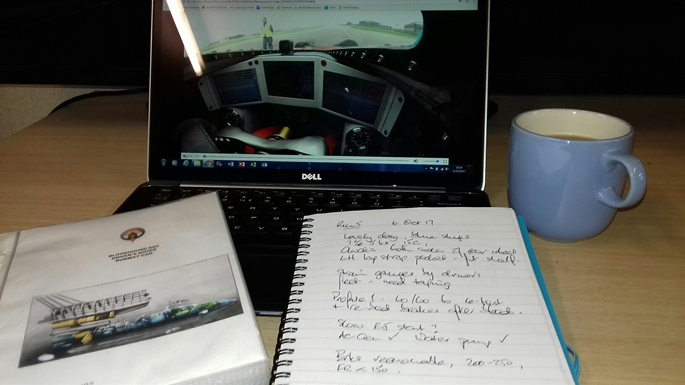Every time BLOODHOUND SSC runs at Cornwall Airport Newquay, Andy Green produces a ‘run report’ summarising what was planned, what the Car actually did, and key learning points to improve the Car and the teamwork for future runs. Each run report also records the weather conditions, which can affect things like jet engine performance, Car handling and brake effectiveness.
Andy makes a series of notes each time the Car is run, recording what he sees in the cockpit and how the Car performs. He then goes through the cockpit video very carefully, to check that nothing has been missed, before publishing the run reports for the team.
As you can imagine, it's been very busy at Newquay, so we're publishing a selection of the run reports here to give you a flavour of what Andy Green reports on and how the testing developed over time.
How to read the reports
As you would expect, the run reports use a lot of abbreviations and assumptions that the team is familiar with. To help you read the reports, here are some of the more common ones:
Where we test
The dynamic tests were done on part of the southern taxiway at Cornwall Airport Newquay. This is known as ‘Delta’ taxiway and access points are labelled D1, D2, D3, D4, etc. BLOODHOUND ran between D2 and D4, which is a section about 4,000 feet (1,200m) long, with safety over-runs at both ends.
Jet engine NL
Jet Engine NL = low pressure spool speed, as a percentage of maximum rpm (NH, the high pressure spool speed, is less relevant to power output).
Dynamic test profiles
- 50mph using up to 60% NL power (initial test of brakes and steering)
- 50mph using up to 60NL (further brake tests to establish grip limit)
- 75mph, 75NL (confirm results at slightly higher speeds)
- 100mph, max dry power (compare braking distances up/downwind when possible)
- 125mph, max dry
- 150mph, min reheat
- All of the above profiles will be repeated as required, for things like bedding in the brakes.
Fuel
- Fuel is measured as a percentage of the Car’s fuel capacity. With only the main tank in use for runway runs, the maximum capacity of the Car at Newquay is around 60%. Fuel percentage is gauged before and after a run, and dynamically calculated when the Car is running, so the readings may be slightly different.
Team call-signs
Team call-signs include:
- ‘Tower’ (Jessica Kinsman, Run Controller)
- ‘Start Team’ (Tony Dineen, start team crew chief and EJ200 jet engine specialist)
- ‘Recovery’ (Martin Roper, recovery team crew chief)
- ‘Eng’ (Stuart Edmondson, head of engineering operations)
- ‘Hawkeye’ (Martyn Davidson, operations director),
- and of course ‘BLOODHOUND’
You can read the first run report below, and then follow the links to read later run reports.
Run Report – Run 1 – 4 Oct 17
Aim
Run Profile 1 (60NL, 50 mph). Bedding in the brakes, functional check of steering, suspension, etc.
Operation
1430L. Weather 14 C, 1010 mb, wind 4 o’clock 17 kts
Delta taxiway, approx. 4000 ft available.
Fuel 61% (i.e. full main tank). Shutdown 47%, run duration 7:30.
No 2-way comms between the Car and Tower. Other radios are having the same problem, it would appear that Tower’s handset is being attenuated. Plan is to relay through Start/Recovery/Eng as required to maintain control.
- Brakes off, power at Idle, brake to a halt to confirm Car rolls easily and brakes work
- Brakes off, power below 50NL, slow decel to stop.
- Brakes off, 60 NL to 50 mph, brake pressure 30 Bar gradually increasing to 50 Bar. Brakes temps similar all round, just above 100 C
- One more slow accel/decel to the end of the run. Brakes still limited effectiveness, not yet bedded in or hot enough to work properly.
Summary
Successful first run, starting to bed in the brakes. Steering and suspension feel good up to 50 mph, the Car immediately feels well sorted and easy to drive.
Procedural points
- Comms relay worked well, allowing safe and effective airside ops.
Technical points
- Poor comms with Tower
- Driver air system needs further work
- Distance indicator not working


